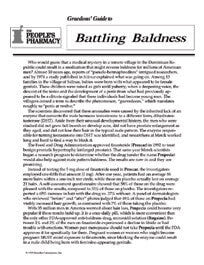Link to your individual collections by creating a new linklist in the Navigation section of the admin.
You can then have it appear here by choosing your new linklist under Customize Theme / Sidebar.

Show 1275: The Vicious Cycle of COVID and Diabetes
There are at least two pandemics raging through the world at this time. The first is obesity. The second is, of course, COVID-19. Diabetes sits uncomfortably at their intersection. In a vicious cycle, diabetes makes COVID-19 infections more likely and more dangerous. Meanwhile, COVID-19 can trigger diabetes or make it worse. There’s a similar feedback loop between obesity and diabetes.
Type 1 and Type 2 Diabetes:
In the most common form of diabetes, type 2, body tissues develop resistance to insulin and end up having trouble utilizing glucose. In type 1 diabetes, the beta cells of the pancreas stop making insulin completely. As a consequence, none of the body’s cells can utilize glucose unless the person is able to inject the appropriate amount of insulin at the correct intervals. We generally think of type 2 diabetes as sensitive to changes in the environment, since it is closely linked to obesity as a risk factor. However, viral infections can trigger type 1 diabetes. Consequently, the pandemic is also contributing to an increase in type 1 diabetes.
The Vicious Cycle of Diabetes and Inflammation:
People with diabetes start with higher levels of inflammation in their bodies. When the immune system fights infection, it produces inflammatory compounds called cytokines. That explains why individuals who already have high levels of these compounds might be more vulnerable to a cytokine storm as an expression of severe COVID-19. Unquestionably the best treatment for this complication is systemic steroid treatment. However, steroids, especially in high doses, raise blood sugar and make diabetes much harder to control.
Obesity and Metabolism and Another Vicious Cycle:
The usual explanation for obesity is that people consume more calories than they expend–they eat too much and move too little. However, this simple energy balance paradigm is now being questioned by some nutrition researchers. They suggest that food quality may be even more important than food quantity. In particular, when people eat highly-processed quickly digested foods high in sugar and refined grains, their bodies respond with insulin that quickly adds energy to the fat cells and may leave other body tissues wanting. As a consequence, people may feel hungry too soon after eating and consume more snack foods, keeping the vicious cycle rolling.
Our guest, Dr. Mitchell Lazar, describes how he counsels his patients with diabetes to eat. In addition, he extolls the benefits of continuous glucose monitoring to help people determine exactly how their food choices change their blood sugar.
How Does Circadian Rhythm Affect Blood Sugar?
When we think about risk factors for developing diabetes, we will certainly list metabolic syndrome and obesity. Moreover, many people recognize that genetics can play a role. But how often do we think of shift work or other changes to our daily schedule? Circadian rhythm can have a powerful impact on metabolism, although it may be difficult for shift workers to address this problem. Getting the eating schedule as close to “normal daytime” as possible may help. Adopting a time-restricted eating plan or intermittent fasting could also be useful. However, people with diabetes need to work closely with their health care providers to make sure that intermittent fasting does not result in episodes of very low blood sugar.Finally, Dr. Lazar offers some advice we can all use to lower our risk of developing diabetes.
This Week's Guest:
Mitchell Lazar, MD, PhD, is the Willard and Rhoda Ware Professor in Diabetes and Metabolic Diseases, and the Director of the Institute for Diabetes, Obesity, and Metabolism at the University of Pennsylvania. This is the link to his research laboratory: https://www.med.upenn.edu/lazarlab/




